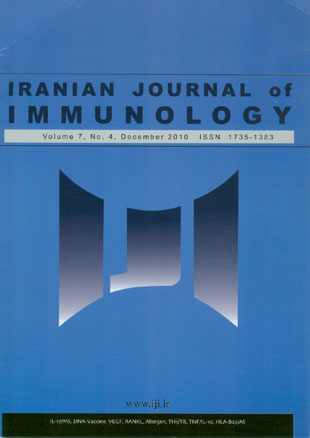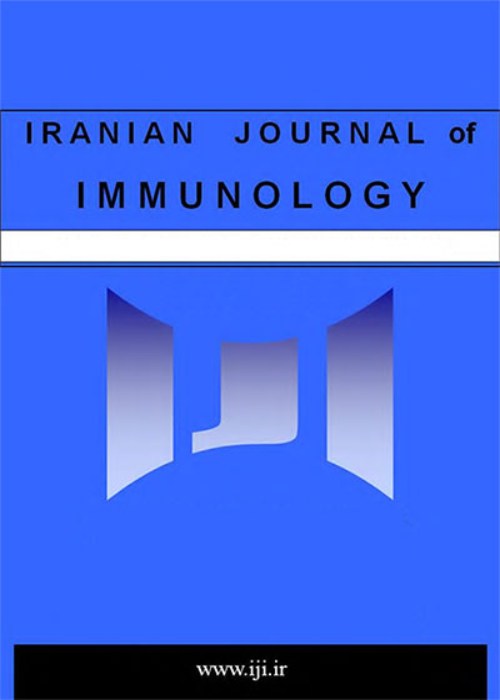فهرست مطالب

Iranian journal of immunology
Volume:7 Issue: 4, Autumn 2010
- تاریخ انتشار: 1389/11/18
- تعداد عناوین: 8
-
-
Interleukin-17A and Interleukin-17F mRNA Expressions in Peripheral Blood Mononuclear Cells of Patients with Multiple SclerosisPages 202-209Bakground: Multiple sclerosis (MS) is a CD4+ T cell-mediated autoimmune diseaseaffecting the central nervous system (CNS). It was previously believed that Th1 cells werepathogenic T cells in experimental autoimmune encephalomyelitis (EAE). However, thefunctional role of Th1 cells in EAE has been reconsidered upon the discovery of IL-17-producing T cells which are consider as dominant effectors for inducing autoimmune tissueinflammation.ObjectiveThe objective of this study was to assess the role of IL-17A andIL-17F in MS pathogenesis.MethodsWe evaluated mRNA expression of IL-17A andIL-17F in thirty-five Iranian patients with relapsing–remitting MS (RRMS) and twenty-fivehealthy controls by Quantitative Real Time PCR.ResultsThe results of this study showed a twenty-fold increase in the expression of IL-17A mRNA in MS patients compared to the control group (p < 0.0001). IL-17F mRNA expression in MS patients was thirty three-times greater than control group (p = 0.0008). IL-17A mRNA expression in periphery was positively correlated with expression of IL-17F transcripts in MS patients and controls (p < 0.01 and p < 0.05, respectively).ConclusionThese results indicate the critical role of Th17- mediated cytokines in development of MS which classically has been considered as a Th1-mediated disorder. The results of this study showed, for the first time, the importance of IL-17F in MS immunopathogenesis.
-
Pages 210-216BackgroundDNA vaccines are third generation vaccines which have made promises to combat infectious diseases. Cationic liposomes are used as effective delivery systems for DNA vaccines to generate stronger immunity.ObjectiveEncapsulation of pcDNA3.1+PA plasmid, encoding protective antigen (PA) of Bacillus anthracis (B. anthracis) into cationic liposomes, and evaluation of its effect on specific humoral specific immunity against PA were aimed.MethodsThe liposomes containing pcDNA3.1+PA plasmids were preparedwith phosphatidylcholine (PC), dioleoyl phosphatidylethanolamine (DOPE) and 1,2-dioleoyl-3-trimethylammonium-propane (DOTAP) using dehydration-rehydration method. BALB/cmice were immunized by intramuscular (IM) injection to investigate the immunogenicity ofthe formulations. The resulting specific antibodies against PA, total IgG, IgG1, IgG2a andIgG2b isotypes, were evaluated by enzyme linked immunosorbent assay (ELISA) method.ConclusionA higher concentration of specific IgG against PA was found in sera of a group immunized with the encapsulated plasmid compared with the naked plasmid alone. This difference was significant for IgG1 isotype
-
Pages 217-225BackgroundThe pathogenesis of many diseases is correlated to irregularity in vascular endothelial growth factor (VEGF) expression. Results from several association studies show that variation in the level of VEGF expression is related to polymorphic sequences within the VEGF gene. Additionally, there are many studies showing that some gene polymorphisms significantly influence the pharmacokinetics of immunosuppressive drugs.ObjectiveThe aim of this study was to determine the influence of immunosuppressive drugs on VEGF production in individuals with different VEGF genotypes.MethodsARMS-PCR was used to genotype VEGF polymorphisms at positions -1154 and -2578 within the promoter of VEGFgene. A VEGF-specific ELISA was used to determine the influence of immunosuppressivedrugs on VEGF production in PBMCs of individuals with different VEGF genotypes.ResultsSuppressive effect of mycophenolic acid was observed just in individuals with GG -1154/CC -2578, GG -1154/CA -2578 and GA -1154/CC -2578 haplotypes. Additionally,VEGF was significantly suppressed in all individuals after treatment with rapamycin exceptthose who had AA -1154/CA -2578 and AA -1154/AA -2578 VEGF genotype combinations.ConclusionResults of a recent study revealed that MMF treatment might be effective inpreventing chronic renal rejection only in recipients with IL-10 high producer genotype.Additionally result of another study showed that CYP3A5 genotype markedly influences thepharmacokinetics of rapamycin in kidney transplant recipients. Therefore with regard to ourresults, different suppressive effect of mycophenolic acid and rapamycin on VEGFproduction might also be dependent on VEGF genotype
-
Pages 226-233BackgroundReceptor activator of nuclear factor kappa B ligand (RANKL) is one of the key cytokines in the induction of osteoclastogenesis both in vitro and in vivo. Several reports indicated the presence of sRANKL in gingival crevicular fluid of patients with periodontaldiseases.ObjectiveTo determine the presence of RANKL in peri-implant crevicular fluidsamples of implants with peri-implantitis, peri-implant mucositis and healthy controls.MethodsIn this study, 40 implants were categorized as clinically healthy, peri-implant mucositis and peri-implantitis according to the clinical and radiographic findings. Filter paper strips were used to collect peri-implant crevicular fluid for 30 seconds in the base of the crevice/pocket. Peri-implant crevicular fluid (PICF) samples were obtained from buccal and lingual aspects of implants. Plaque index, probing depth, gingival index and bleeding on probing were recorded at six sites per implant. Enzyme-linked immunosorbent assay (ELISA) was performed to determine the PICF levels of sRANKL.ResultsThere were no statistically significant differences in sRANKL concentration between healthy group, peri-implant mucositis and periimplantitis (p=0.12). There were also no statistical correlation between the concentration of sRANKL and probing pocket depth (R=0.051, p=0.65), or any of the other clinical regarding (p>0.05). No differences between the mean sRANKL concentration in thebuccal and lingual sites were found (p=0.693).ConclusionOur results may suggest that peri-implant crevicular fluid analysis of sRANKL in conjunction with some other osteoclastogenic mediators could be further investigated in further well-designed prospective longitudinal studies on a larger-scale sample size in the evaluation of dental implants.
-
Pages 234-239BackgroundAsthma and allergic rhinitis are among the most common diseases in the world.ObjectiveThe aim of this study was to detect, by skin prick test, aeroallergens in allergic patients in Sari, Mazandaran in north of Iran.MethodsThis is a prospective study of skin prick test of aeroallergens in asthma, allergic rhinitis and their combination with clinical diagnosis. Three hundred and seventy five cases aged between 5 to 50 years, were referred to Tooba and Boo-Ali allergic centers of Mazandaran University of Medical Sciences between December 2006 and July 2009. The aeroallergens studied included house dust mites (Dermatophagoides farinae, Dermatophagoides pteronyssinus), cockroaches, feather, aspergillus, Alternaria, pigweed, nettle, oak and maple.ResultsOf the studied individuals, 175 cases were males (46.7%) and 200 were females (53.3%), of which 156 (n=41.5%) reacted to allergen extracts. In asthma, allergic rhinitis and their combination, the respective positive percentages were 26.6%, 22.9%, and 32.6% for Dermatophagoides farinae; 26.6%, 25.3%, and 23.3% for Dermatophagoides pteronyssinus; 12.7%, 17.4%, and 11.6% for cockroaches and 16.5%, 4.7%, and 7.0% for the feather. Other allergens were positive up to 5percent. Total IgE levels were elevated in 56.4%, 53% and 60.5% of asthmatic, allergicrhinitis and the combination group, respectively. Eosinophils count was elevated in 40.5%,33.2% and 37.2% of the same groups, respectively.ConclusionThe hypersensitivity tohouse dust mites is very common in north of Iran which may be attributed to the warm and humid weather of this area.
-
Pages 240-246BackgroundInterferon gamma (IFN-γ), a cytokine produced by a variety of cells is involved in the immune response against M. tuberculosis. It activates the production of other cytokines and molecules that kill mycobacterium. IFN-γ also has diagnostic role in identification of active and latent tuberculosis.ObjectiveTo determine the level of IFN-γ in the blood of TB patients.MethodsNinety-one subjects were selected, including 54 active TB patients and 37 healthy controls. Among 54 TB patients, 27 had confirmed TB and 27were clinically diagnosed as having TB. IFN-γ concentration was determined in their bloodby an ELISA technique.ResultsIn TB patients, Mean + SD of IFN-γ was 48.69 + 28.78 pg/ml while it was 12.99 + 5.70pg/ml in the control group (p <0.001). Significant differencesin the level of IFN-γ were observed among confirmed TB patients, clinically diagnosed TBpatients and the control group (Mean + SD 59.68 + 28.78, 36.85 + 24.76 and 12.99 + 5.70 pg/ml, respectively). Furthermore, a significant negative correlation was observed between the concentration of IFN-γ in TB patients and the duration of anti-tuberculosis therapy.ConclusionIFN-γ level was high in both clinically diagnosed and confirmed TB patients as compared to a control group. Measurement of IFN-γ production is helpful to diagnose active tuberculosis, but further research is required.
-
Pages 247-251BackgroundThe renin-angiotensin system has an important role in hepatic inflammation and fibrosis. Renin-angiotensin system blockade by angiotensin-converting enzyme (ACE) inhibitors provides some protective effects against hepatic fibrogenesis. Captopril as an ACE inhibitor can decrease inflammatory mediators and attenuate hepatic fibrosis in the livers of bile duct ligated (BDL) rats.ObjectiveThe present study was conducted to investigate the effects of captopril on cytokine production in hepatic fibrosis induced by a bile duct ligationmodel in rats.MethodsMale rats were divided into four groups including; control, shamoperated, BDL, and BDL plus captopril (10 mg/kg/day, orally). After 28 days of treatment,the livers were removed for cytokine analysis. Hepatic interleukin (IL)-10 and tumor necrosis factor (TNF)-α levels were measured.ResultsCaptopril treatment decreased the hepatic content of the proinflammatory cytokine TNF-α and increased the anti-inflammatorycytokine IL-10.Conclusionthe present study suggests that the protective effect of captoprilon hepatic fibrosis is likely to be mediated by cytokine production.
-
Pages 252-256BackgroundSpondyloarthropathies are a group of closely related inflammatory arthritis which involve the axial skeleton and are negative for rheumatoid factor.ObjectiveThis casecontrol study was conducted to examine HLA- B27 positivity in patients with seronegative spondyloarthritis (SSA) as per ESSG criteria and compare the frequency with healthy controls because a lower positivity is reported in Indians.MethodsThe study included 453 patients and 200 controls. HLA -B27 typing was done by microlymphocytoxicity and/or by sequence specific primers (SSP) using commercial kits. Patients were categorised as Ankylosing Spondylitis (AS), Undifferentiated Spondyloarthropathy, SSA with inflammatory bowel disease, reactive arthritis, psoriatic arthritis and juvenile spondyloarthropathy.ResultsHLA-B27 antigen was present in 56% of patient and 3.5% controls with highest frequency in juvenile spondyloarthropathy (80%), followed by AS (76%). The P value 0.001 for all categories of SSA and overall Odds ratio was 34.9.ConclusionThis study showed HLA-B27 frequency slightly lower than reported in Caucasian SSA patients and in our opinion HLA- B27 testing is extremely useful in young patients with suspected SSA


